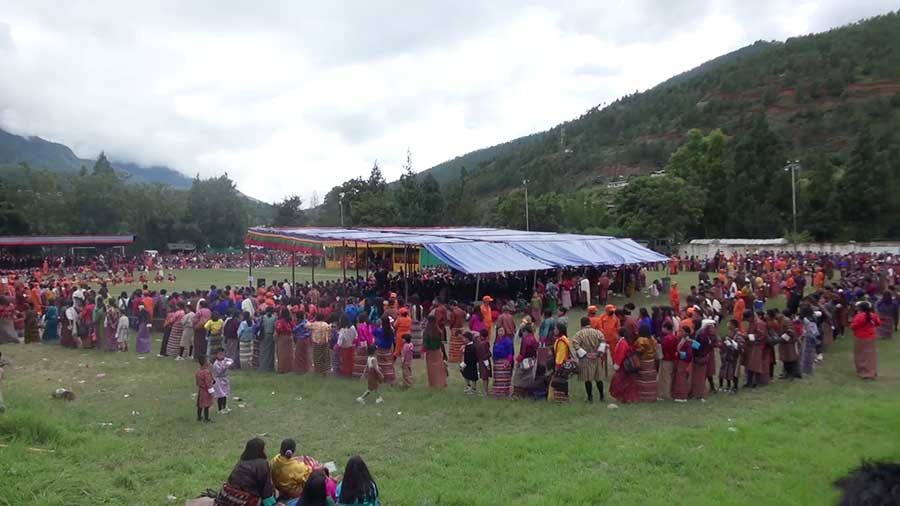
The reconstruction of the iconic Wangdue Phodrang Dzong is close to completion. Built in the 17th century by Zhabdrung Ngawang Namgyel, the historic fortress withstood a couple of natural disaster before it was completely destroyed by a major fire accident in June 2012. Since then offices and events of the dzong were relocated to other places. One such event is the annual Tshechu. However, with the dzong slowly rising to its former glory, this will be the last Tshechu away from the dzong.
 The annual Tshechu away from the historic dzong did not stop the devotees from coming to witness the sacred mask dances. This year, the Tshechu is at Bajo Higher Secondary School’s football ground. While there were several tents for the public, it was not enough. Most of them found themselves exposed to the scorching heat followed by strong wind in the afternoon and light rainfall in the evening to wrap the weather up.
The annual Tshechu away from the historic dzong did not stop the devotees from coming to witness the sacred mask dances. This year, the Tshechu is at Bajo Higher Secondary School’s football ground. While there were several tents for the public, it was not enough. Most of them found themselves exposed to the scorching heat followed by strong wind in the afternoon and light rainfall in the evening to wrap the weather up.
They have braved this for too long. By this time next year, they can witness the sacred dances inside the dzong.
“The construction of the new dzong is complete now. However, we could not conduct our annual Tshechu in the new dzong this year since the dzong is not yet consecrated. So, this Tshechu will be the last event to conduct in an open place. From next year, we can conduct the annual Tshechu in the new sacred dzong,” said Sonam Jamtsho, The Wangdue Phodrang Dzongda.
People who have been witnessing the annual Tshechu every year welcomed the news. Except for the last two years when the Tshechu was closed to the public due to the pandemic, the devotees have been visiting the open grounds to witness the annual Tshechu.
Holding an infant, Kinley Wangmo, from Bajo is a regular at the Tshechu. She says she is excited and can’t wait to witness the Tshechu inside the Dzong.
“We thought we will not be able to witness the Tshechu inside the dzong after its destruction by the fire. But we are very happy as the construction of the new dzong has been completed during our time itself,” she said.
“It is quite difficult due to the heat to watch the event in an open place. Especially, it is challenging for elderly people. It would be better and more convenient if the event is conducted inside the dzong. We can have shades and also go around and receive blessings from the sacred relics of the dzong,” added Pelki, from Guma in Punakha.
“Elderly people are suffering a lot while witnessing the Tshechu in open places. We are extremely happy that we will be able to conduct the Tshechu inside the dzong by next year. It would definitely help the elderly people,” said Chador, the Thedtsho Gup.
 Considering the growing population and number of people turning up to the festival, some people are worried about how the new courtyard can accommodate the spectators.
Considering the growing population and number of people turning up to the festival, some people are worried about how the new courtyard can accommodate the spectators.
“There is limited space inside the dzong. The population has drastically increased just in front of our eyes. So, I feel it would be difficult to accommodate even half of the spectators inside the dzong,” Kinley Wangmo said.
“The dzong has a very congested place, and if the number of people is like today, I am worried that there will be a high risk of causing suffocation to elderly people and children inside the dzong,” Gup Chador added.
Dispelling these concerns, the Dzongda says the new courtyard of the Dzong is spacious for the public. He says even the office corridors can be used for spectators if the need at all arises.
“The number of people coming to witness the event is on an average 3,000 to 4,000 while performing outside today. So, this number of people can be easily accommodated inside the dzong,” he reassured.
Tshechu is a homage to Guru Rinpoche who was responsible for the spread of Buddhism in Bhutan. There is no better place other than Dzong or monasteries to conduct such a sacred festival. And the courtyard in the Dzong will again host the most sacred festival next year after more than a decade.
Changa Dorji, Wangdue Phodrang
Edited by Sonam









